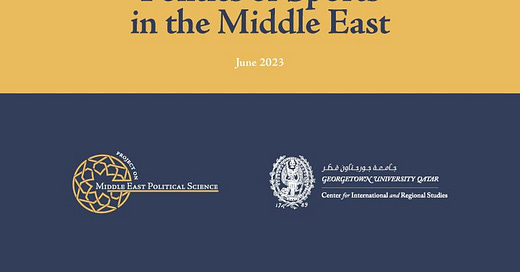Sports and Politics in the Middle East
Our new collection of essays digs deep from the stadium level to controversial global investments
The Doha World Cup last December made for a riveting spectacle. The postcolonial showdown between Morocco and France in the semifinal and the superhuman performances of Kylian Mbappe and Lionel Messi in the final will ensure that the football won’t soon be forgotten. The spontaneous eruptions of pro-Palestinian solidarity in the stands set down a standard of renewed performative pan-Arab unity, while Saudi Arabia and the UAE looked for ways to match and surpass Qatar’s successes. Meanwhile, the fierce criticism of Qatar’s labor exploitation and intolerance towards LGBTQ communities by human rights organizations and activists left scars.
In January, inspired by the World Cup, POMEPS partnered with Georgetown Qatar’s Center for International and Regional Studies to bring together a group of scholars, mostly from the MENA region, who had long been studying the intersection between sports and politics. CIRS made a perfect partner, since it had been running a multi-year project on football in the Middle East, and had recently published an outstanding volume edited by Abdullah al-Arian on the topic (see my review here). We are now thrilled to announce the publication of the papers from that workshop, available here as a free, open access PDF issue of POMEPS Studies. As Zahra Babar and I point out in the introduction, “we had hoped for a broad look at a wide range of sports, and to move the conversation beyond just football. There is so much more to say about sports, politics, and society in the Middle East: the responses to Tunisia’s ascendant female tennis star Ons Jabeur, as an example of the critical need to examine women and sports; Saudi Arabia’s investment in an alternative professional golf tour and eventual acquisition of the PGA Tour; Formula One and its ever-expanding presence and popularity in the Gulf; the emergence of the UAE’s central role in hosting major international cricket tournaments, which makes a lot of geographic and financial sense given the massive, local South Asian fan bases; the bids by Gulf states to host the Olympics and the various Asia Cups, Africa Cups, Gulf Cups, and other subregional and regional competitions. But ultimately, all of our authors opted to focus on football. We blame the World Cup.”
The papers in the collection range widely across multiple countries and different levels of analysis. Many of the papers focus on the domestic political level, showing how football matches and their fans encapsulate local political, identity, and ethnic conflicts. Curtis Ryan looks at the rivalry between al-Wehdat and al-Faisaly as a mirror for Jordanian-Palestinian identity politics in Jordan. Ehsan Kashfi examines Azeri football fans and ethnic assertation in Iran. Sefa Secin takes on political polarization in football matches in Turkey. Nazanin Shahrokni shows how the struggle for women to watch football matches in theaters instead of the stadiums from which they were banned intersected with Iranian politics around women’s rights (see my review of her book on this topic here). Ronnie Close looks at the tragic entry of Egyptian Ultras into revolutionary politics. Ibrahim Rabaia examines the political and identity ramifications of Palestinian football. Eman Demerdash compares the role of football in national identity formation in Morocco and Palestine.
Other essays broaden the lens, looking at the economic and political dimensions of football at the regional and global levels. Majd Abuamer and Yara Nassar document the spectacular growth in Gulf investment in global sports over the last decade, positioning it between sportswashing, political competition, and savvy investments (the Saudi acquisition of the PGA tour and rumors of Qatar’s purchase of a share in the Washington Wizards NBA team happened after the piece was written, and only reinforce the points). Saleh Mahmoud shows the difficulty of finding domestic competitive clubs for investment in Egypt, as compared with those global opportunities. Marc Owen Jones contributes an incisive look at the headspinning social media gamesmanship around the World Cup and other global sporting events and acquisitions. And Dag Tuastad shows how Islamist movements and regimes struggled to react to the widespread popularity of the sport.
I’m delighted to have this collection out. As a longtime sports fan, I really appreciated the deep dives into the local passions aroused by football clubs and rivalries and the careful examinations of how those could map onto national political controversies and lines of contention. And at the global level, it seems like there’s a new story every day about Saudi Arabia, the UAE or Qatar buying up famous teams, or (in the case of pro golf) entire sports. Neither trend seems likely to recede any time soon. It’s small wonder that the World Cup inspired so much good writing on these themes; I expect that we’ll be seeing a lot more in the coming years, especially as the research networks built during these workshops continue to develop. Download POMEPS Studies 48 for free now!




